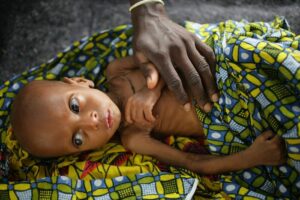By Mark Ellis

The U.N. and international aid agencies are warning of food shortages in the Sahel Region of West Africa, which includes portions of Chad, Niger, Mali, Burkina Faso, and Nigeria. The worst country impacted, Niger, needs millions of dollars in food aid or its crisis could become catastrophic, according to a report by the BBC.
“The hunger season is beginning here in the next few months,” reports Andrew Harding, with the BBC. “A lot of people will be running out of food very soon.” The aid agencies are pushing for more aid so the crisis coming in the next few months doesn’t become as bad as the recent famine in the horn of Africa.
On the arid plains of Niger, with little signs of vegetation amid the dusty reddish earth, brightly clad women pile stones around ditches they dig as catch basins in the event any rain falls. They will attempt to trap rainwater and divert it to their fields, in hopes of a future harvest.
The women are paid two dollars per day by the U.N. World Food Program for this work, which will allow their families a meager survival during the coming months.
“Years of unpredictable rains, intense poverty and a poor harvest in 2011 have left 5.5 million people –over a third of the country’s population — facing significant food shortages this year,” says Thierno Diallo, with MercyCorps in Niger. “A deeply worrying 1.3 million of that number are at serious risk from hunger and need immediate humanitarian assistance,” he notes.
Late rains and damage from insects at the end of last year left more than 70 per cent of farmers with no crops to harvest. Families struggle to make food last from one October harvest to the next during normal years, but with no stored food and little grazing for weakened livestock, the number of people with access to food is falling rapidly, according to Diallo.
Food prices have doubled in many areas. Those with any assets are selling what they have left to buy food, and others are taking on debts. Many people are leaving their communities altogether, in search of work, food and water. Schools are emptying as children leave with their parents to find work for food, according to MercyCorps.
“Women in particular are often missing meals for an entire day or longer,” Diallo observes.
In Filingué, one person reported to MercyCorps, “We have nothing left to eat in this village. Some households are only getting one meal within 36 or 48 hours; now we eat flowers and leaves of the ‘Garbey’ tree. We pound the flower, mix it with lot of water, drink some and keep some so that any time a child cries, we give him or her some mixture to drink and they calm down.”
“There is nothing we can do and sometimes they get diarrhea. We have nothing left, so we need help. This is the worst crisis we have seen in our village for so many years. In 2009 we had at least few of us that could harvest. This year no one could get anything out of the farms. We lost everything. We need help.”
Niger’s government – now a democracy – has taken important steps to acknowledge the scope of the problem. While government leaders have expressed concern, there is no sign of panic at this stage, according to the BBC.
If there is a future harvest, it will not appear until October, so June, July and August will be the most difficult months for survival in this region.




Data on global food aid deliveries in metric tons are from the database of the International Food Aid Information System (INTERFAIS), which was developed by WFP as a contribution to a coordinated international response to food aid shortages. INTERFAIS is a dynamic system, which involves the interaction of all users, represented by donor governments, international organizations, non-governmental organizations, recipient countries and WFP field offices. They are sharing information and data on food aid transactions.-.
Most up to date write-up straight from our own blog page
<http://foodsupplementcenter.com/
Comments are closed.